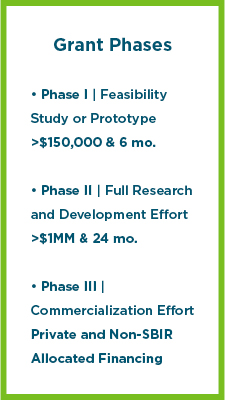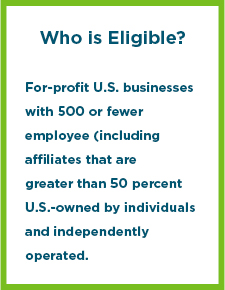Rev1 Ventures Supports Entrepreneurs Competing for SBIR/STTR Grants
A discussion with Muyang Hu, Rev1 Director of Venture Acceleration
What if your startup could attract $1MM or more in capital without giving up equity or creating debt?
An opportunity like that would be worth a serious look, right?
Rev1 thinks so, too, and that’s why we provide specific help to portfolio companies that decide to pursue for the U.S. Small Business Administration’s (SBA) Small Business Innovation Research (SBIR) and Small Business Technology Transfer (STTR) grants.
MJG: Can you give us a brief explanation of what SBIR/STTR grants are all about?

MH: The U.S. Small Business Administration’s (SBA) Small Business Innovation Research (SBIR) and Small Business Technology Transfer (STTR) programs provide milestone-driven awards to small businesses.
 Annually, approximately $2.5B is set aside for SBIRs and STTRs to support research, development, and financing of cutting-edge technologies. Eleven federal agencies participate in the SBIR program and five agencies in the STTR program. Ohio is one of the ten states that receive the majority of SBIR/STTR funding.
Annually, approximately $2.5B is set aside for SBIRs and STTRs to support research, development, and financing of cutting-edge technologies. Eleven federal agencies participate in the SBIR program and five agencies in the STTR program. Ohio is one of the ten states that receive the majority of SBIR/STTR funding.
MJG: How do startups benefit from SBIR/STTR grants?
MH: SBIR/STTR grants provide from $150,000 to $1MM or more of non-dilutive funding. Entrepreneurs do not have to give up shares in their companies. There is no impact to the company’s P&L or balance sheet, and assuming the company operates with integrity and completes the grant work they commit to doing, SBIR/STTR grants do not have to be repaid.
The program is milestone-based, which adds discipline and structure to a startup’s development process. It’s a great way to add momentum and de-risk your product.
Besides the financial advantages, these grants create an opportunity to share ideas with some of the finest scientists and engineers in the country.
These programs are a proven path to success. Companies like Symantec, Qualcomm, and 23andMe are just a few SBIR/STTR graduates.
MJG: This is a very competitive program, and navigating the process is challenging. How does Rev1 help?
MH: We encourage entrepreneurs to have a conversation with Rev1. We have assisted multiple startups with NIH SBIR/STTR applications and with other government agencies. We will be realistic about the work involved. Most of the time, the companies come to us with a good idea of what they are looking for. We can also help an entrepreneur identify opportunities that could fit with the company’s business plan.
Last year, we helped more than a dozen companies either submit or resubmit their grants. The hit rate on first-time grants with NIH, for example, is about 10 percent, so you have to stick with it. The good news is that after getting the first grant approved, approvals seem to come a little easier.
A lot of companies that come to us have various backgrounds with SBIR/STTR. Some are familiar with the process and have done it before. For those types of companies, we do a lighter touch—for example, reviewing the proposal they have written or providing a checkpoint on their supporting documentation.
If the company has never done this before, it is a whole new field for them, and we will provide more coaching along the way. We walk them through the process, step by step, break the workplan down into pieces, and establish weekly meetings and deadlines.
MJG: What is the entrepreneur’s responsibility for submitting grant applications?
MH: It is the company’s project. The science has to come from the technical team. We are good at letting them know what pieces are missing in the proposal and areas where they can improve. If the entrepreneur is 100% on board and committed to submitting for the SBIR/STTR, we are in.
MJG: What is a simple thing that entrepreneurs don’t know about the SBIR/STTR process that if they knew in the beginning could significantly improve the process for them?
MH: There’s a lot an entrepreneur can’t know until they actually submit a proposal, but there are three time-saving things for an entrepreneur to understand right up front.
- Every solicitation for proposal typically has an assigned program officer. This person’s job is to review proposed technologies in an abbreviated format and tell applicants if the technology fits the mission of the solicitation. Program officers are listed in the solicitation document. They are real people with real phone numbers and emails. Companies are not alone. The program officer can be an entrepreneur’s internal advocate.
Once an entrepreneur identifies a solicitation that looks like a fit, draft up a 1-pager (e.g., specific aims page or executive summary) and schedule a 30-minute phone call with the appropriate program officer. Rev1 can help entrepreneurs plan that call.
- Every SBIR/STTR applicant must be registered in each required government database before any proposal can be submitted. Depending on which government agency you’re submitting your proposal to, there are usually multiple places that the small business needs to register. The registration process can take six to eight weeks. Even if you have registered before, new registrations or renewals may be required. Each registration may expire at different times.
Many entrepreneurs don’t realize that multiple registrations are required or that they take so much time. Rev1 can help identify the requirements so that applicants can complete registration as soon as possible.
The SBIR/STTR grant opportunity is large, and the process is complex. Entrepreneurs don’t know what they don’t know. Rev1 stands ready to help. Contact us.

